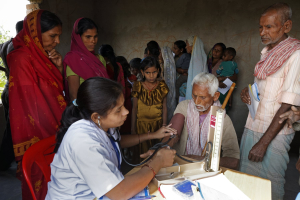Ladder Funding: A Collaborative Approach to Changing the World
 According to the National Center for Charitable Statistics, there are more than 1.5 million charitable organizations in the United States. Despite the many different forms they take, all of them have something in common: a desire to create meaningful change in the world. Yet despite this commonality, nonprofits have a tendency to operate in silos. Some years ago, that realization led me to a question: What might happen if like-minded funders actually worked together to bring about the change they wished to see in the world?
According to the National Center for Charitable Statistics, there are more than 1.5 million charitable organizations in the United States. Despite the many different forms they take, all of them have something in common: a desire to create meaningful change in the world. Yet despite this commonality, nonprofits have a tendency to operate in silos. Some years ago, that realization led me to a question: What might happen if like-minded funders actually worked together to bring about the change they wished to see in the world?
As the executive director of The Pollination Project (TPP), a public nonprofit that provides seed funding to early-stage grassroots projects around the globe, the question is particularly germane. We believe there is significant untapped wisdom and power in solutions that emerge and grow from the bottom up. We use the money we raise to support a vibrant grassroots community of global changemakers who seek to spread compassion for the benefit of all.
Every day of the year, our network uses an intentional, peer-led vetting process to select a new project to receive $1,000 in seed funding. That’s right — every day. As individual projects blossom, their leaders can access capacity-building support, encouragement, and networking opportunities within a specific geographic or focus area. We’ve found that supporting individuals at the local level is a particularly robust way to bring about change.
But as our grantee network has grown and the projects we support begin to reach maturity, the need for project leaders to be able to access financial capital beyond the scope of our micro-grants has become ever more clear. In response to that need, we have developed a collaborative approach with other funders we call Ladder Funding.
What is “Ladder Funding”?
Imagine providing a step stool, or ladder, to project leaders that enables them to reach new heights in their levels of engagement with donors and supporters. As an organization that provides seed funding to early-stage projects, TPP is the “bottom rung” of the ladder.
Sometime after project leaders have received $1,000 in seed funding from us, we evaluate them based on the impact of the work they have done and their alignment with the values and priorities of TPP partners who may be able to provide additional funding in support of their longer-term goals. If we see a match, we connect them directly to those partners, thus helping them climb the ladder of funding.
The model has many advantages, for both project leaders and funders:
It is low-risk. We’ve seen success with this model, as it addresses both the challenges that many project leaders face in accessing funding while at the same time providing our partners with access to trusted, vetted grantees.
It is streamlined. The reports that project leaders submit to TPP at the end of their seed grant from us serve as an application of sorts to our funder partners. It’s an approach that saves time and streamlines a process that typically is labor-intensive for everyone involved.
It promotes diversification. Project leaders are connected to potential funders directly, which gives them a leg up in terms of diversifying their base of funding and building relationships that can help strengthen their work over the longer term.
It is relational, not transactional. Our model is based on a more holistic approach to the grantee-funder dynamic, allowing TPP and funders in our network to serve as true partners to the projects they fund while shifting the focus away from the transactional nature of that relationship.
We’ve had great success with this approach to date and have partnered with several funders, including the McGinnity Family Foundation, to provide our project leaders with additional financial and non-financial capital. By building their capacity in this way, we ensure that they have the resources to carry out their work more effectively and efficiently.
Perhaps more important, our approach creates opportunities for leaders to connect with the missions and values of like-minded peers and funders. And by emphasizing collaboration rather than fragmentation, we are helping to create impact that is more deeply aligned with a vision for a just and equitable world.






